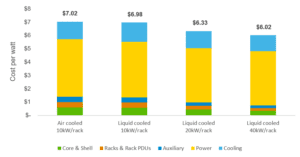Liquid cooling has been around for some time now, but has tended to be very niche… until now. There’s a lot of buzz about liquid cooling as a necessary technology to address the trend of increasing Chip thermal design power (TDP) in data centers and at the edge. There are some clear and understood benefits of liquid cooling, including the reduced need for water, space and energy savings.
But when it comes to capex, there is more uncertainty. There are questions as to whether there will be a big price premium to implement, and this becomes an obstacle to adoption. So, our group, Schneider Electric’s Science Center, decided to get to the bottom of this question. We conducted a detailed cost study, White paper 282, Capital Cost Analysis of Immersive Liquid-Cooled vs. Air-Cooled Large Data Centers. It goes into depth of our methodology, assumptions, data, and results, but I’ll give you a summary here.

Capex comparison at like-for-like densities
We analyzed a 2MW data center, at 10kW per rack, for both traditional and liquid cooled designs.
- Air-cooled – Packaged chillers, pump packages, CRAHs, hot aisle containment, no raised floor
- Liquid-cooled – Chassis-based immersive architecture (check out this paper to learn of the different architectures)

Assuming the pricing level is based on near-term deployment at scale.
The air-cooled data center cost was $7.02/watt and the liquid-cooled data center was $6.98/watt. Roughly equal. In the paper, we show a waterfall diagram so you can see exactly where the cost adders and cost savers were. For instance, when you go to liquid-cooling, you remove the chillers, you remove the CRAHs, and you save on switchgear & UPS because the load is smaller without the server fans. But, you add dry coolers and CRACs, you have additional pumps and piping cost, and you add a premium for the liquid cooling technology at the server and rack level (sealed chassis, dielectric fluid, liquid heat sinks, micro pumps, etc.).
Capex savings as density increases
Liquid cooling enables compaction of the IT. This results in the space savings I mentioned earlier, but it also results in less IT racks and less rack PDUs. We analyzed the capex of the 2MW data center using liquid cooling with 2x and 4x compaction.
With 2x compaction, or 20kW/rack the data center capex is $6.33/watt. That savings per watt came primarily from the additional core & shell, rack, rack PDU, and containment savings. This translates to a 10% savings over the traditional air-cooled scenario presented.
At 4x compaction, or 40kW/rack, the data center capex is $6.02/watt. Same drivers as the previous, but greater magnitude of savings since the compaction is greater. This translates to a 14% savings over the traditional air-cooled scenario presented.
Capex shouldn’t be an obstacle to adopt liquid cooling
Our analysis demonstrated that liquid cooling does not come at a cost premium when compared to air cooling at similar densities, and when you consider the compaction that the technology enables, there is opportunity to even save on capex. As the technology matures and manufacturing efficiencies improve, additional savings can be expected. Check out the white paper if you want to read all of the details of the analysis.
Leave a comment below or check out other blog posts from the Data Center Science Center team.



Conversation
Very compelling comparison…Liquid Cooling wins -hands down
Thanks, Charles. Yes, it certainly has some compelling advantages. We have some other content related to liquid cooling if you want to check it out here – https://www.se.com/ww/en/work/solutions/for-business/data-centers-and-networks/liquid-cooling/